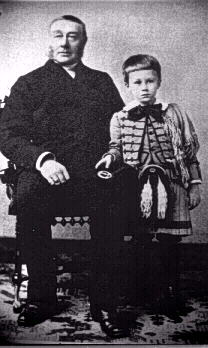Kilts and Kilt Suits
 kilt suit was a natural transition for boys who had grown to old for
dresses.
The style was not limited to Scoland and England. Affluent Americans generally
looked to England as the arbiters of good taste and were soon also dressing their sons in kilts. Scottish
ancestry had little to do with the choice of kilts, although families
with actual Scottish ancestry might be particularlyblikely to folloe
the style.
kilt suit was a natural transition for boys who had grown to old for
dresses.
The style was not limited to Scoland and England. Affluent Americans generally
looked to England as the arbiters of good taste and were soon also dressing their sons in kilts. Scottish
ancestry had little to do with the choice of kilts, although families
with actual Scottish ancestry might be particularlyblikely to folloe
the style.
Mothers of the era loved to
dress their sons
in kilts and fancy
blouse.
Younger boys were dressed in bodice kilts rather than
proper kilts, usually without sporrans. Kilt suits for little boys were
 quite popular in America. Some mothers even selected sailor kilts,
sailor suits with middy
blouses, but a kilt instead of short trousers. (As the kilt was of the
same material as the blouse and not plaid it was more of a skirt than a
kilt.) Older boys wore proper kilts, but with a
variety of shirts varying from lace trimed blouses to shirts with stiff
Eton collars and bow ties.
quite popular in America. Some mothers even selected sailor kilts,
sailor suits with middy
blouses, but a kilt instead of short trousers. (As the kilt was of the
same material as the blouse and not plaid it was more of a skirt than a
kilt.) Older boys wore proper kilts, but with a
variety of shirts varying from lace trimed blouses to shirts with stiff
Eton collars and bow ties.
Boys kept dressed in kilt suits after graduating from their baby dresses and smocks
would usually not have their hair cut and often wore
curls or
bangs. While in kilt suits, it was not unusual for boys to wear hanging
curls and perhaps bangs but the curls were cut when the boy was
finally breeched (allowed to wear pants), an occasion which would brought tears to the eyes of many a
doting mother.
Accounts vary as to the
attitude
of boys to kilts as oposed to other styles
prevalent at the time. Some clearly disliked the kilt as girlish.
Others
thought Fautleroy suits with lace collars and Russian tunics to be worst.
Probably the favorite of most boys before they graduated to more
adult-looking
styles was the sailor suit.
Kilt suits became increasingly rare after the turn of the century, but
kilts have continued into modern days. Some schools in Scotland and
Ireland adopted them as a
school uniform. This is no longer the case, but they are still
commonly worn for dress occasions
at many Scotish schools. Some of the boys don't much like the idea,
especially
the English and occasional
American boys at the schools. Kilts are also worn
by Scottish boy scouts. They are also seen at
highland gatherings around the world and at formal occasions. Irish boys
around the world wear them at step dancing competitions called feises.
Ring bearers in Scotland and England
also sometimes wear kilts.

Kilt Links
1920s Fashion article
Navigate the Boys' Historical Clothing Web Site:
Kilt history
Additional Information
Christopher Wagner
[
Introduction]
[
Chronology]
[
Clothing styles]
[
Biographies]
[
Bibliographies]
[
Contributions]
[
Boys' Clothing Home]